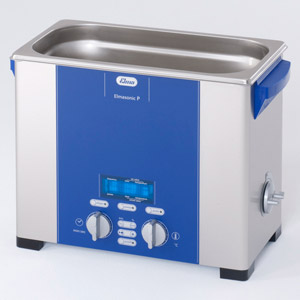Cleaning Microtube Manifolds: An Alternate Approach
A benchtop ultrasonic cleaner proved superior to an automated microplate washer with integrated manifold tube cleaning.
Rachel Kohn, Ph.D., Tovatech LLC, Plano, TX

Biopharma labs routinely use microplates for cell-based assays, microsphere-based assays, and ELISA applications. Microplate washers are used to clean the plates. Manifold tube clogs are the most common source of failure on plate washers. Some plate washers come with built-in ultrasonics to clean clogged microtubes, but they are often not favored by lab personnel who prefer to wash the manifolds off-line. Procedures to remove clogs and contaminants in manifold tubes can involve time consuming manual insertion of a cleaning wire or stylus tool into each tube.
I was contacted by a researcher at one major pharmaceutical laboratory who was looking for an alternate off-line method to replace laborious manual manifold washing. Since I wasn’t familiar with this application for an ultrasonic bath, I recommended conducting a cleaning trial with a demo unit. For this trial the researcher planned to clean a manifold with the following dimensions: 5.5 x 3.7 x 2.5 inches. I selected the Elmasonic P60H and associated basket for this demo. The basket for the P60H is 10 x 4.1 x 3.7 inches, a good size for the manifold.
Here is the response from the researcher to my inquiry about the progress of the trial:
“Awesome, awesome! The demo went well! I’m really looking forward to purchasing the larger size sonicator and batching multiple systems in one go. I was pleasantly surprised at how effective it was. It is great to not manually clean each manifold.”
The researcher wanted to batch 4-6 manifolds for cleaning and purchased the 7.5 gallon Elmasonic P300H, a unit with a much larger capacity than the demo model.
Benefits of Ultrasonic Cleaning Manifold Tubes
Ultrasonic cleaners are widely accepted as a fast, thorough, safe means of removing tenacious contaminants from any surface that can be safely wetted. Applications in the healthcare industry include cleaning medical and surgical instruments prior to sterilizing or disinfecting, cleaning dental tools and prosthesis, and cleaning delicate laboratory glass such as cuvettes.
Ultrasonic cleaning manifold tubes uses a process called cavitation – the implosion of millions of microscopic vacuum bubbles in an ultrasonic cleaning solution.
The vacuum bubbles implode, (not explode) on contact with contaminants in the tube, blasting them loose and leaving a clean surface.
Features Supporting Ultrasonic Cleaning for Manifold Tubes
The dual-frequency, 37/80 kHz P series ultrasonic cleaners offer features especially useful for cleaning manifold tubes as well as other laboratory and pharmaceutical equipment.
Setting the Elmasonic P to 80 kHz allows its smaller cavitation bubbles to better reach microtube interiors. Users have the option of using 37kHz for more tenacious contaminants, or cleaning other lab equipment. The unit can be programmed to alternate between the two frequencies.
Other features include variable ultrasonic power, timed cleaning cycles and a heater. Once established, users can program their cleaning cycles with parameters visible on the unit’s digital display.
Accessories for the Ultrasonic Manifold Tube Washer System
Parts positioning in the ultrasonic cleaner basket is critical to achieving desired cleaning results.
Parts positioning is assisted by basket hardware accessories encompassed in a modular basket system. Here are two of several positioning options that can be configured:
One includes holder sets that support manifold pin sets in a vertical position allowing contaminants to fall from pin interiors.
A second is divider walls separating baskets into sections, allowing plates to be positioned on an angle, also facilitating tube draining.
In Summary
A benchtop ultrasonic cleaner with programmable operating cycles proved superior to automated plate washers in removing manifold tube clogs.



